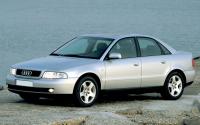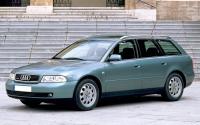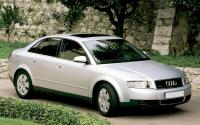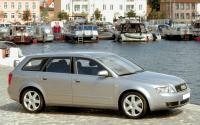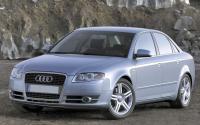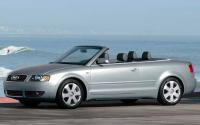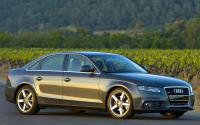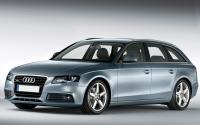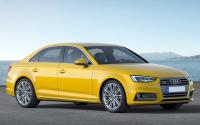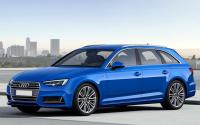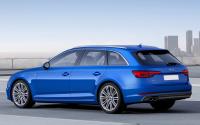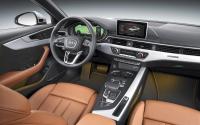The A4 has gone through five generations of modifications and is based on the Volkswagen Group B platform. The automaker's internal numbering considers the A4 as a continuation of the Audi 80 line - the initial A4 is designated as the B5 series, followed by the B6, B7, B8 and B9. The B8 and B9 series are built on the Volkswagen Group MLB platform shared by many other Audi models.
The A4 body is available as a sedan and station wagon. Second (B6) and third (B7) the A4 generation had a convertible body, but then from the fourth generation (B8) became a separate model called the Audi A5. There is a sports version of the A4 called the Audi S4.
The development of the automobile began in 1988 and at the end of this year the first design sketches were created. By 1991, the exterior design was selected and frozen until production in 1994. The interior design was completed in 1992 and experimental production began in the first half of 1994. Development was completed in the third quarter of 1994.
The car's closest competitors are BMW 3 Series, Volkswagen Passat, Kia Optima, Infiniti G, Honda Accord, Hyundai Sonata, Opel Insignia, Peugeot 408, Ford Mondeo, Mazda 6, Mitsubishi Galant, Mercedes C-class, Nissan Teana, Renault Laguna, Toyota Camry, Subaru Legacy And Skoda Superb.
Audi B5 (1994—2001)
First generation Audi A4 (Typ 8D) debuted in October 1994, began production in November 1994, European sales began in January 1995. Sales in North America began later in September 1995. The car is built on the Volkswagen Group B5 platform (PL45), on which is based Volkswagen Passat fifth generation. Two types of bodies were produced - a 4-door sedan and a 5-door station wagon (Avant).
Throughout the seven-year production, minor changes were constantly made to the car. Significant reconstruction was carried out in 1997. Updated some engines and added a 6-speed manual transmission. Another facelift was made in 1999. The changes were mostly cosmetic, but affected almost all external elements.
The choice of engines is very large. Petrol 4-cylinders with a volume of 1.6 to 1.8 liters with a capacity of 101 to 180 hp, 6-cylinder V-shaped with a volume of 2.4 to 2.8 liters with a capacity of 150 to 381 hp. Diesel 4-cylinder 1.9-liter power from 75 to 115 hp, 6-cylinder V-shaped 2.5-liter engine with 150 hp. with.

Audi B6 (2000—2006)
Next Audi A4 (Typ 8E) debuted October 10, 2000, now based on the Volkswagen Group B6 platform (PL46). The new styling of the car was developed under German automotive designer Peter Schreyer between 1996 and 1998, inspired by the design for the second generation Audi A6 (C5), introduced in 1997.
The body was in three versions - a 4-door sedan, a 5-door station wagon and a 2-door convertible. Avant (station wagon) was introduced in June 2001 and entered European showrooms in September 2001.
The choice of engines for the most fastidious taste. Petrol - 4-cylinders with a volume of 1.6 to 2.0 liters with a capacity of 101 to 187 hp, 6-cylinder V-shaped with a volume of 2.4 liters (168 HP) and 3.0 liters (217 HP). Diesel - 1.9 liters (l4, 99-128 hp) and 2.5 liters (V6, 153-178).

Audi B7 (2004—2008)
Audi introduced a new generation of the A4 at the end of 2004 with the internal designation B7 (Typ 8E/8H). The car is built on the Volkswagen Group B7 platform (PL46). Despite the new designation, the B7 is a heavily upgraded and updated version of the B6 with revised steering settings, suspension geometry, updated internal combustion engines, improved electronic stabilization system (ESP). The front grille assembly has changed to a tall trapezoidal shape the same as on the third generation Audi A6 (C6), however, the dashboard and interior remained largely unchanged.
The body was also in three versions - a 4-door sedan, a 5-door station wagon and a 2-door convertible.
A number of engines received many additions. In 2005, a direct fuel injection system was put into operation (FSI) for 2.0 TFSI and 3.2 V6 FSI petrol engines, as well as other improvements that increased power to 197 hp. and 252 hp respectively. These engines use a four-valve-per-cylinder configuration.

There are four transmissions to choose from - 5 or 6-speed manual, 6-speed automatic «Tiptronic», as well as continuously variable transmission «Multitronic» (CVT) with a choice of seven speeds.
Audi B8 (2009—2015)
Audi presented the first official photos of the B8 series A4 in August 2007 and showed the car to the public at the Frankfurt Motor Show in September 2007. The car is built on a modular longitudinal platform Volkswagen Group B8 (MLB/MLP), a platform that is also used for the Audi A5 Coupe. Cars with a convertible body became known as the Audi A5, only two bodies remained to choose from - a 4-door sedan and a 5-door station wagon.
The MLP platform allows the front overhang to be reduced, resulting in a longer wheelbase without increasing the overall length. This effectively redistributes the center of gravity slightly to the rear, improving handling and balancing the vehicle's weight between the front and rear axles. Also, the new platform allowed to increase the space in the cabin and luggage compartment, and the curb weight of the car decreased by 10%.

Transmissions appeared as many as five of the most diverse options - 6-speed manual transmission, 6-speed «Tiptronic», 8-speed automatic transmission, 7-speed DSG «S tronic», and «8 speed» variable speed drive «Multitronic».
Audi B9 (2015-present)
In June 2015, the next generation Audi A4 version of the B9 was released (Typ 8W) - the fifth model for the name A4 and the ninth generation of the Audi 80 / A4 series as a whole. The official launch took place at the Frankfurt Motor Show in September 2015. The car is built on the Volkswagen Group B9 platform (MLB/MLP). The B9 is slightly larger than the previous generation, but weighs 120 kilograms less. There are also two bodies to choose from - a 4-door sedan and a 5-door station wagon.

The choice of transmissions is possible from three options - 6-speed mechanics or 7 and 9-speed DSG «S tronic».

